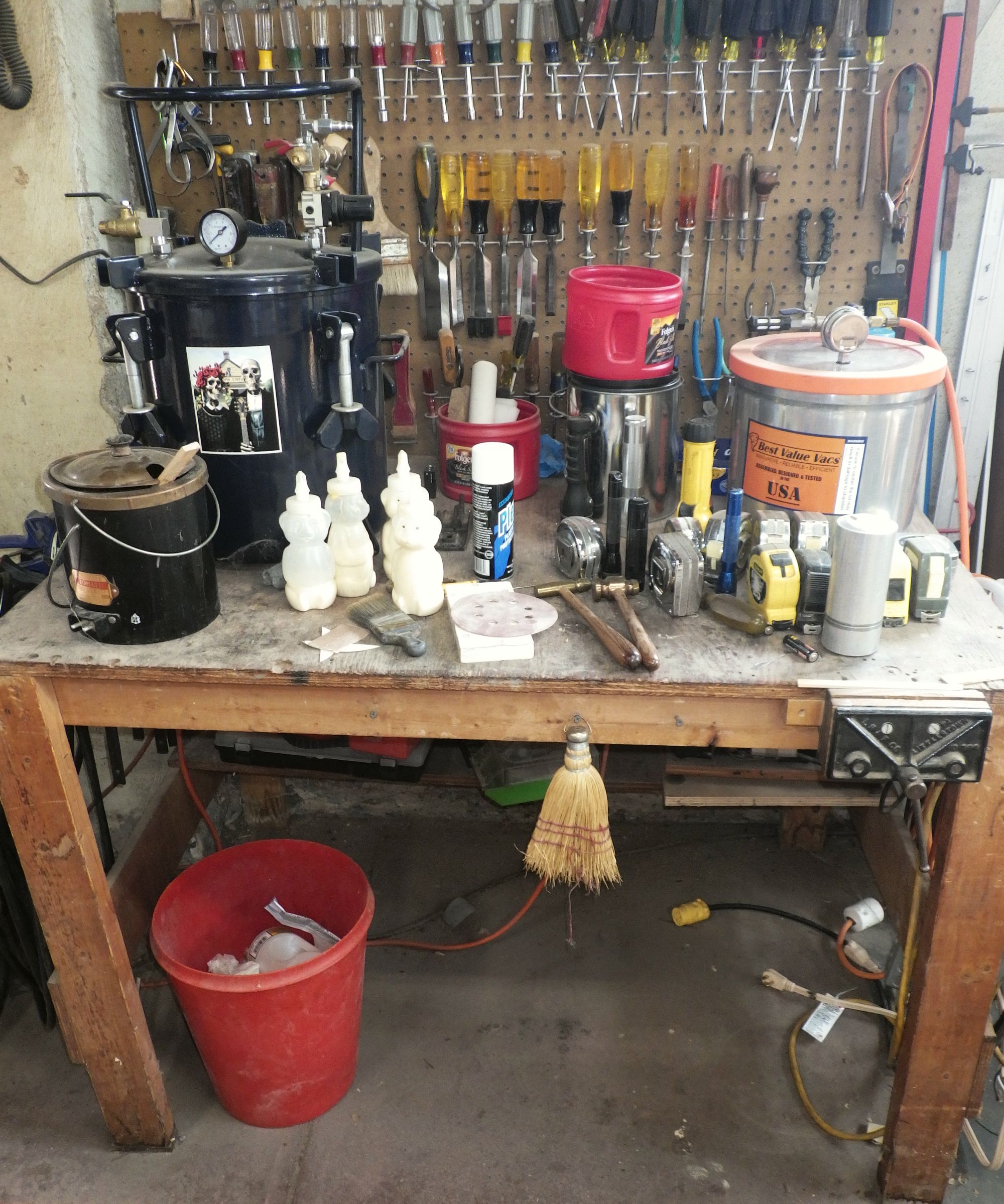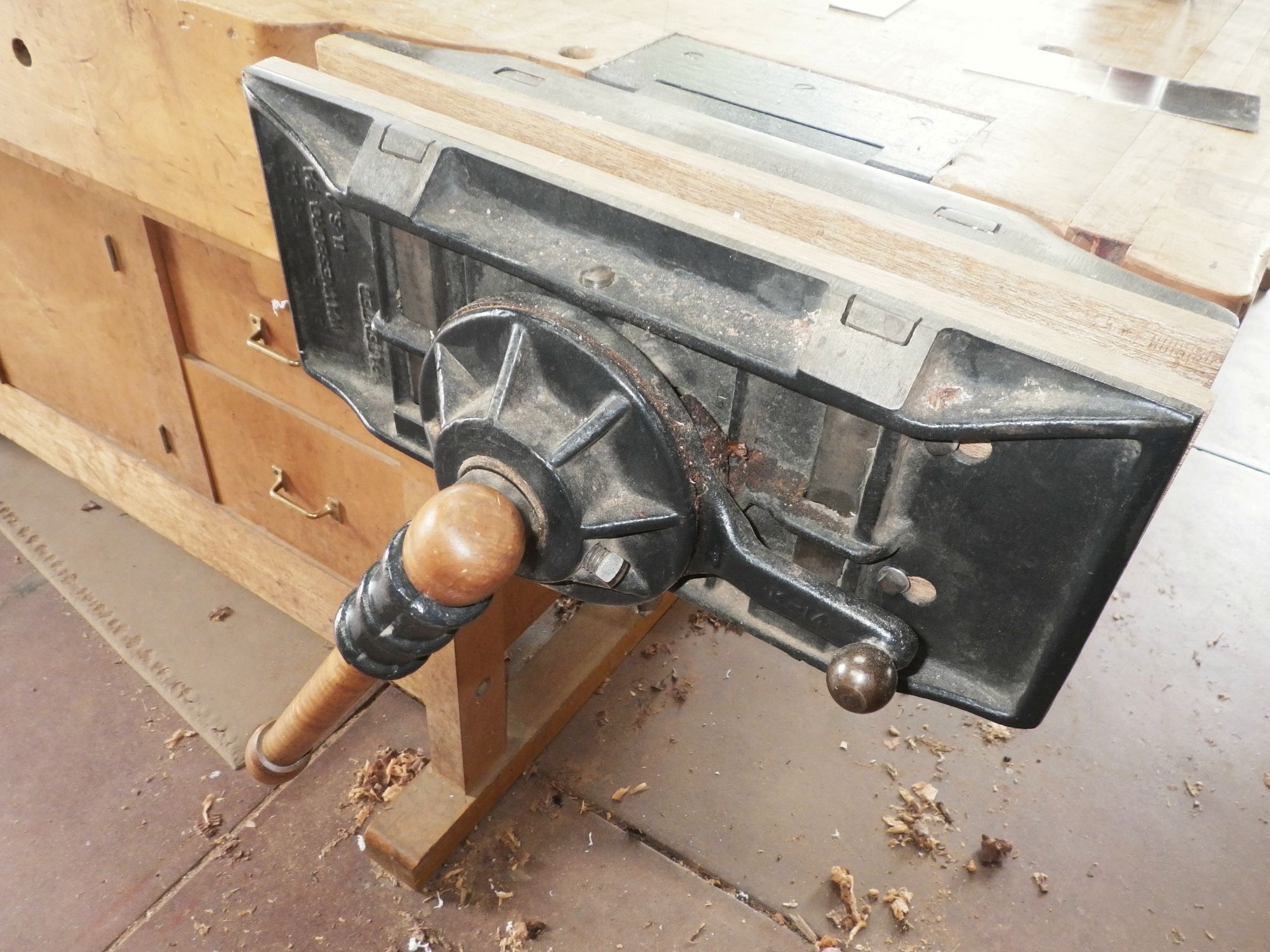DarkHollowDulcimers
1594
13
0

A tour of benches I've built for my shop over the years, with some of the thinking, where there was any, that went into them.
Pictures were taken yesterday, mostly, and no attempt at cleaning up first was made, so this is the natural state of my shop.

First bench: CDX, 2x4s, and pegboard. Built a lot of dulcimers, coffee tables, and my first "real" woodworker's bench on this, so it will always have a place in my shop. The Littleston front vise is the only front vise I've seen from them.

Next, a traditional bench based on the plans in Tage Frid's book. The tool well always fills up with junk, but I love it. Both vises are very handy, and this was the center of the shop for many years.
After my Mom died, I asked my Dad to join me in the shop to help out; one day he attached this switched outlet box to my beloved prized bench, and I was internally horrified, but told him it was awesome, obviously. Turns out he was right, the outlet has been super handy for tools, as well as chargers.
The only problem with this bench: it's too light, and moves under aggressive hand planing of hardwoods.

Bench abuse.

Saw bench was made from old hemlock timbers left behind from the buildings previous life as an auto dealership in the 30s. Originally it had a plywood top, but was replaced with this 1 5/8" thick 3' x 8' clear pine top. More on the pine in a bit.
The grooves are for sleds and miter gages. This end sports a Unisaur, and the other a Delta 12/14.

Solving the "too light for heavy planing" issue, this bench has a 1 3/4" maple top with a 6" apron all around, and 30" x 86". It's super stable, and now is my main workstation. I intend to take it with me when I die, as I assume there will be chairs to fix wherever I end up.

This end has a nifty Twin Screw vise which gets a lot of use.

And over here it has an Emmert patternmaker's vise. You can angle the jaws, and the entire vise can tilt forward, as well as rotate. This one is mounted into the bench, so that the rear jaw is flush with the front apron. The apron has dog holes, so this facilitates holding long work.

These are various tools that can be used in the round dog holes: holdfast, Jorgensen bench clamp, carver's screws, and brass bench dogs.

So, the clear pine tops came in as two 3' x 16' horizontal drafting tables from Sun Shipyard. Each was supported by a two-drawer cabinet on a small cast iron pedestal on each and, and a large cast iron pedestal in the middle.
One of the cabinets was trashed, and there was no room for any 16' benches, let alone two of them. So I used an 8' piece for the saw table we saw before, and made this 3' x 14' bench with a 3' x 5' vertical drafting board. I only know how to draw on a vertical board; there is no way I could draw on a horizontal drafting table.
This is supported by the remaining three original cabinets, and one of the original center supports. Bike parts live underneath.

Started to accumulate too many extra vises, so I sold a few, and built this bench with some of the others. Plus, I wanted to build a wagon vise, and wanted a large flat bench for vacuum veneering.
The top is 2 1/8" solid oak, 3' x 6'. This side has a Reed quick-acting vise, and a Yost patternmaker's vise. This vise is mounted proud of the bench, which makes it easier to swivel and angle the vise.

The other side has this vintage Massey's lever vise. It uses a cam and ratchet to tighten the vise, as opposed to a screw.

The wagon vise. The jaws are lined with buffalo hide, and there are vintage bench dogs along the bench. The handle has been temporarily removed, because I had made the knobs too tall, and they stood proud of the bench top, so I'm gonna fix that.

The Reed quick-action woodworker's vise. This sees a fair amount of use, as it's pretty stout.

Trestle legs, with wedged stretcher tenons.

Is this a bench? 50" x 12' mdf top for the radial arm saws. They both see a lot of use.
The top is supported by the Delta RAS base on the right, and two Craftsman machinery stands in the very fashionable Power Bronze motif. Metal bar is stored underneath.

This bench has a 2 1/2" thick oak slab top, 13" deep x 64" long. It sports a little Parker vise, a pile of Arkansas stones, and a grinder.
The bench originally was on cast iron legs, but received the oak trestle base when the iron legs were repurposed.

Parker oval slide vise; "farm & home duty."

I sharpen all my plane irons, chisels, carving tools, and woodturning gouges and skews with this thing, and it works great.

And here is where those iron legs were repurposed to. Found this 1938 Craftsman 12x54 lathe for $200, restored it, and mounted it to the 2 3/4" x 13" x 60" cherry slab, and added the legs and cabinet. I've had so much fun with this thing.

Rolling carts made from steel machinery stands. Craftsman power bronze frame on the right, with #2 common walnut top and drawer fronts. Top is 30" x 30".

A few of these things rolling around the shop; a 3/4" plywood box, mdf top, frame and panel doors, leftover and sample hardware hinges and pulls. I have tons of figured veneer, so I laid up shop cabinet door panels for veneering practice.

The next bench was built after I found one cast iron leg on ebay. It was a cool bench leg, so I bought it, and took it to Emmanuel King at Cattail Foundry, and he cast three more of them.
Guitar parts are currently stacked on this bench, because of a bunch of cutting board orders. Back to the guitars next week.

You can see the legs here. The pulls are just slices off an aluminum extrusion.
Painted drawer faces are mdf.
The top is mdf with 1/2" common walnut veneer on both sides, capped with walnut.
The bicycle wheel is from a folding bike I'm restoring for a friend.

Gressel vise is handy because you can adjust the height and swivel, to position your work to the best advantage.

I didn't make this bench; this is a Sjöbergs carver's bench that my siblings and I bought for my Dad. He made wonderful songbird carvings and duck decoys, after he retired.
Unfortunately, the bench is mine now.

The most recent bench, using the remaining two cast iron legs that Mr. King cast, #2 common walnut lumber, and a vintage Sheldon lever vise.
I built this just to sell, which it did.
My local lumber yard will accumulate 100bf lifts of common cherry and common walnut, as most people are buying select and better. They then sell the common lumber by the lift for cheap, and I've made lots of money on the material.

Side view of the iron legs. Definitely cool, but I have no idea what the original purpose was.

Top view. New owner was very pleased with his new bench.
I hope you found this little tour of shop benches interest, informative, and most of all, inspiring. Go make something!

PeeWee tax. PeeWee shows the construction of a dulcimer headstock.
xXxSTEVOxXx
I was soooo hoping you had detailed pictures of your wonderful benches. Imagine my delight to have been correct!!
BramGallagher
Thank you for the tour.
PutThePRNDLinD
When my dad was working on projects, if you asked him what he was making he'd always say 'sawdust'...which was true, but also pure dad-joke.